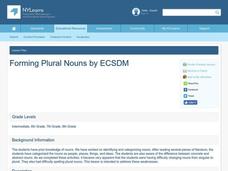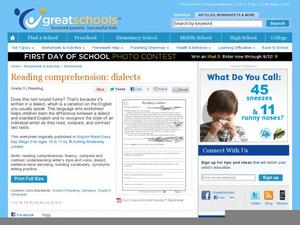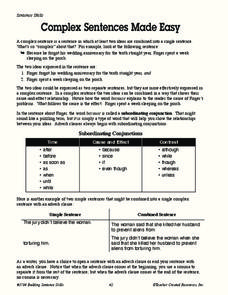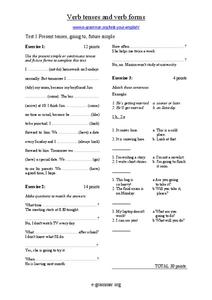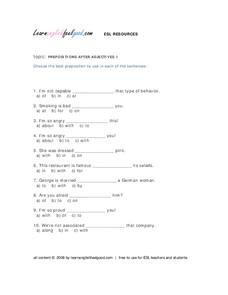Curated OER
Forming Plural Nouns
Interactive SMART Board activities provide young grammarians with practice changing singular nouns to plural nouns. Learners then create collages on which they inscribe the singular and plural form of the noun label.
Curated OER
Scrutinizing Stand-Ins: Working With Nouns and Pronouns
Use the Schoolhouse Rock episode, "Rufus Xavier Sarsaparilla," to introduce a study of pronouns. Learners consider antecedents, cases (nominative, objective and possessive), as well as types of pronouns, and then craft sentences using...
Curated OER
Reading a Dialect
Reading a dialect can be difficult; show readers that it can also reveal fascinating details! They read two extracts from Jane Gardam's The Hollow Land, which is written in a British dialect. Readers answer comprehension questions,...
National Endowment for the Humanities
The President Under the Articles of Confederation
The Articles of Confederation sounds like one big, fancy title to middle schoolers. Here, scaffolded steps help to ease novices into understanding this all-important American document. Discussion questions, lesson activities, and ideas...
Teacher Created Resources
Complex Sentences Made Easy
Support scholars' ability to write complex sentences with a two-page worksheet designed to inform and reinforce. Here, learners obtain a brief overview of what a complex sentence is and how one is made; then apply their new-found...
Curated OER
Verb Tenses and Verb Forms
Practice verb forms with a set of short grammar exercises. Learners fill in the blanks and match sentences to describe events that have already happened, are happening now, or will happen in the future.
Curated OER
English Tenses and Verb Forms
If your class could use some grammar help, this learning exercise could be a good addition to your lesson on verb tenses. Three exercises guide learners through the conditional tense, offering several ways to describe the results of...
LearnEnglishFeelGood.com
Count or Non-Count Nouns?
Many learners struggle with the difference between count and non-count nouns. When do you use a few or a little? Or much or many? Take a look at ten sentences where young grammarians can...
LearnEnglishFeelGood.com
Participles Used As Adjectives
Is a movie interesting or interested? Use context clues to decide which participle would be the most appropriate in each of ten sentences.
LearnEnglishFeelGood.com
Correct Word Order in English
Syntax is important when learning to speak English, and a worksheet with ten sentences can assist English learners in putting words in the correct order. As they read each sentence, they choose which of two answers would be most...
LearnEnglishFeelGood.com
Prepositions After Adjectives
Practice reading context clues with a set of ten sentences within a grammar worksheet. As they examine each sentence, readers choose which preposition would be most appropriate after the adjective shown.
LearnEnglishFeelGood.com
Simple Present or Present Continuous?
Mastering verb tense is an important part of building your learners' reading skills. Young grammarians look over ten sentences and use context clues to decide whether they should use the present or present progressive tense.
LearnEnglishFeelGood.com
Choose the right preposition for each phrasal verb
Clarify the meanings of ten sentences with a fill-in-the-blank worksheet. As young grammarians study the context clues in each sentence, they choose which preposition would best complete the thought.
LearnEnglishFeelGood.com
Fewer or Less?
When do you use fewer, and when do you use less? Learn the difference between the two words with a fill-in-the-blank worksheet that asks readers to make their choice based on the context clues in the ten sentences.
LearnEnglishFeelGood.com
Gerund or Infinitive?
Decide which form of the verb to use in ten sentences. Young grammarians watch for context clues when determining if they should use gerunds or infinitives in the blank spaces of each sentence.
LearnEnglishFeelGood.com
Mixed Verb Tenses
He was running or he has been running? Young grammarians must examine context clues to determine which verb phrase to use in ten sentences.
K12 Reader
Pronouns as Indirect Objects
Pronouns used as indirect objects are the focus of this short worksheet that asks learners to fill in the correct pronoun.
Ms. McLaughlin's Homework Page
Simple, Compound, and Complex Sentences
Find out just how much your pupils know about simple sentences, subjects and predicates, sentence fragments, coordinating and subordinating conjunctions, compound sentences, complex sentences, and more! This review page includes...
BBC
Past, Present or Future Tense
Test your pupils' mastery of verb tenses with quick quizzes. Included here are three quizzes, each at a different level of difficulty.
ESL Library
ESL Grammar Practice Worksheets: Future Tense
Your class is going to get plenty of practice with these future tense worksheets, but will they enjoy themselves? You will have to find out! Learners practice using going to and will in various exercises, practicing with each type of the...
K12 Reader
Animal Adjectives
How would you describe someone who was acting like a dog or a chicken? Teach your class the adjectives that pair with 20 different animals. They'll be able to describe anything canine or crocodilian, and everything in between.
K12 Reader
What’s Being Compared?
Can your pupils find the comparative or superlative adjectives in each of these sentences? To complete the exercise, individuals circle the adjectives and then note down the things being compared.
K12 Reader
Change Adjectives into Adverbs
What do you need to turn an adjective into an adverb? Sometimes you need an -ly, but there are other endings. Ask your learners to change the endings of 29 adjectives in order to transform them into adverbs and complete the provided...
K12 Reader
Adjective Antonyms
Easy or hard? Fast or slow? Invite your class members to practice with antonyms. They identify each adjective and then use provided antonyms to rewrite the sentences.


